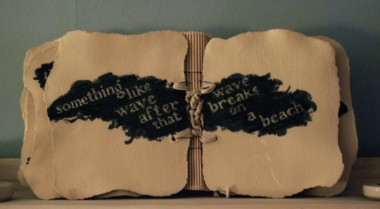One of the things I return to again and again in my work is a process of connecting small individual elements into a larger entity, the separate parts woven together and unified by the flow of words in the text, like the pages of a book.
In the Southbank Centre’s Poetry Library I was given an exciting opportunity to work with the space itself, and to articulate a response to the architectural and conceptual nature of the space. I wanted my work to penetrate the library, not just to hang about in the exhibition area. One of the ways I approached this was to treat certain parts of the space like a big pot, the pillars for example, or the glass lift, or one of the aisles between the bookstacks, and examine how I would respond to that shape and the space contained in a pot I was making.
Here, of course enters the problem of scale. Working in clay obviously imposes some limitations of size – my kiln’s capacity is about 7 cubic feet, which seems to take up quite a lot of room in my London studio, but isn’t huge for a kiln. The shelves are about 19″ square, so the largest individual things I can make are either panels that will fit on one shelf, or pots that fit into the vessel of the kiln space without shelves. These objects are large, but won’t cover a wall. One solution to the size limitation is the ancient art of tiling or mosaic or brickwork – making a large thing from small elements which can interlock or overlap or connect in layers. And the best way I’ve found to make this connection, to interlock the elements, is to allow a text to flow across the sections, to make each tile a word, so that the work is ‘read’ as a whole individual object, just as the brick wall becomes something more than the sum of its parts, or the book unites its pages to an entity.
Several of the works in my Poetry Library exhibition were made like this, using the architecture to determine the form of the work, and setting the text in response to it. Waterfall took its overall form from the shape and proportion of the partition wall, with its sloping top and rather fluid sense of separating space from space:
The text is from Valentine Ackland’s poem By Grace of Water. Here it’s important that the wetness of the raw clay should be present in the fired work, and I’ve aimed for this with the folding of the clay and the physical placing of the letters, setting them like leaves floating and spinning downstream, linking the panels into a whole with the flow of words. The letters were set first with pencil on the dried but still raw clay, then the oxide was painted on with a brush (some areas in the hollows being quite difficult to reach) and then the panels were fired on sand quite slowly to allow for movement and shrinkage in the clay. Then I glazed them, to add to the watery effect, and this needed to be carefully controlled at top temperature to prevent the colour bleeding into the molten glaze. The panels are hung from copper pipes and cuphooks.
Another stimulating problem was the two great pillars bang in the middle of the exhibition space in the Poetry Library. Hard to ignore, these huge pillars run right through the building, down to the earth below, rooting and supporting the whole edifice. I wanted to reflect this sense of solidity, and the cathedral-like effect, with a text that would clothe the pillar like vestments, wrap it in prayer flags, but I also wanted something that would convey a sense of spiritual lightness to balance the gravity.
The poem begins with a rising wind, and I used thin paperclay flags to wrap the pillar in a banner that waves and flaps and streams in that wind. The physical lightness of the paperclay flags allows them to be hung with embroidery silks tied round the pillar, using the same colours as the lettering, and referencing both the domestic and the sacramental. With this banner, the installation was part of the making process; I don’t have room in my studio even to lay out a work as large as this to see if it will fit, so I installed with my fingers crossed. Luckily the form is very flexible, so I was able to adjust it to fit the pillar’s requirements, and in the process I realised that it would work just as well on a flat or curved wall as on the pillar.
And love wells within me and spills over the world
Because of the unknown dark and the great banners unfurled
Out there beyond me, that beyond which folds
About us, warm as life, and is our life, and holds
Our days and deaths and births within its sheltering folds.
(Every Autumn a wind like this wind blows by Valentine Ackland)
Signed one-off, measurements variable but about 1m wide and 2m high, for sale £960
(Most of this text is taken from Working with words, a series of gallery talks given in the Southbank Centre in 2008. The full text can be read in my artist’s book, Journey from Winter, in the Poetry Library’s rare book collection.) For some more banners, please have a look at the Banners page.
To buy or enquire about any work, please leave me a note in the comments box below, or click on contact details.





